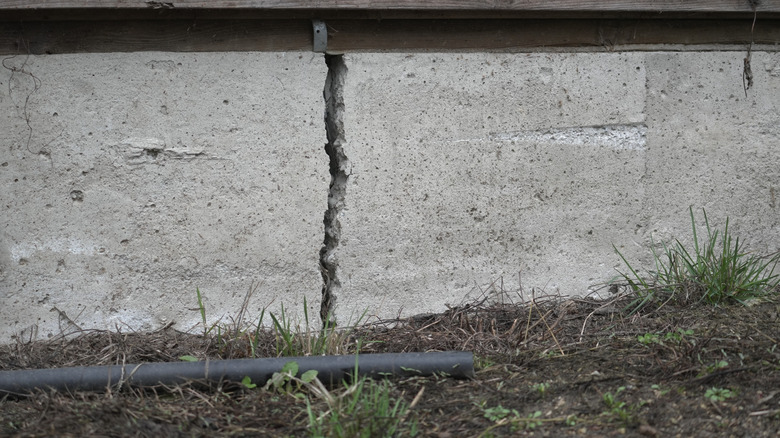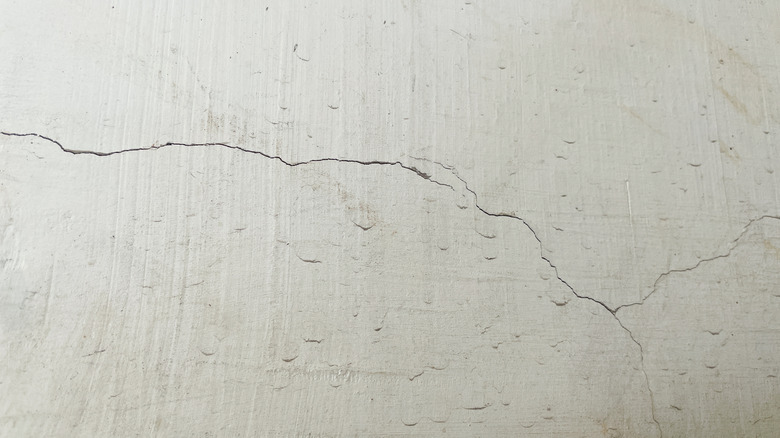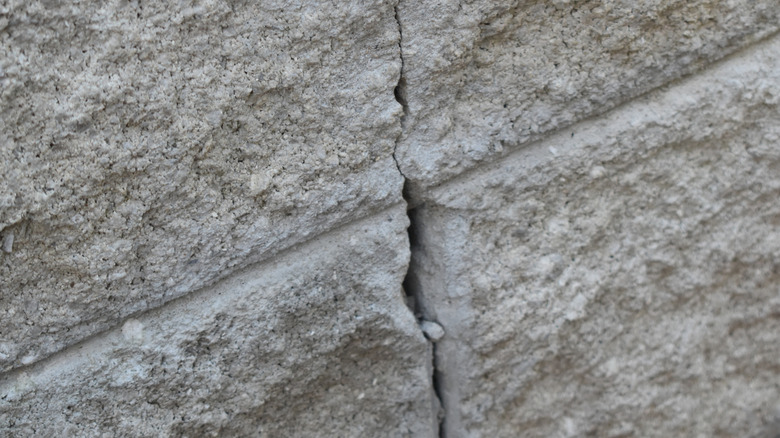Don't Panic! Here's How To Identify And Repair The Cracks In Your Foundation
Imagine yourself walking into your basement after a long time, and as you scan the walls, the first thing you see is a large crack, begging for attention. Although you may think this is a good time to freak out, we recommend you take a deep breath first and closely inspect the crack again. Even though a crack in the wall can be one of the signs there is a problem with your home's foundation, not every crack is created equal. In fact, in some cases, it is even normal to see some cracks appear, like if your home is newly built, for example.
So, how do you identify which type of crack warrants a call to the professionals and which type a DIY patch job (possibly with a coat of paint to hide the doings underneath) will fix? Well, depending on certain symptoms like the width of the crack, its progress across the wall, and its pattern of appearance, you can diagnose the severity of the real issue. Fixing the cracks, on the other hand, involves techniques like epoxy injections, carbon fiber reinforcements, installing wall anchors, and, if the damage is severe, getting immediate professional help. Keep in mind that most of these repairs should be done by professionals.
Hairline cracks should not worry you too much
Hairline cracks should be the least cause of worry for homeowners. These cracks are very thin (1/16 of an inch) and shallow. Most of the time, hairline cracks in homes are just signs that your home's foundation is settling. In new homes, though, they can also appear as the concrete present in the foundation either dries out or cracks due to repetitive changes in temperature. The biggest thing you should watch out for with such cracks is if they are allowing moisture to get inside the basement. You can do this by closely inspecting the crack for dampness.
Having said all that, you should definitely keep on monitoring hairline cracks, since overlooking them can lead to bigger problems down the road. If you can sense water seeping through or the cracks getting worse with time, you should definitely get them repaired. Since these cracks usually appear in new homes, they are often covered by warranties. You can get in touch with your builder to fix the damage. DIY methods of repair include using concrete patching or crack fillers.
Vertical cracks can be concerning if they are too wide
Vertical cracks run straight up, down, or diagonally across your foundation walls. These cracks are less than ⅛ of an inch wide and often occur right in the middle of the wall. Vertical cracks are primarily caused by settlement, a process where the foundation of your house settles unevenly into the soil. This happens because of the shifting or compressing of the ground underneath your foundation over time. Vertical cracks can also appear due to shrinkage of concrete as it cures and the moisture present inside it evaporates.
Vertical cracks are also fairly common to see, especially in new homes, as the weight of the house settles into the foundation. Nonetheless, they can also lead to serious problems related to moisture, such as basement flooding and mold growth. If left unchecked, these can lead to costly repairs in the future and more problems with the integrity of the structure.
One way to tackle vertical cracks in your foundation is injecting an epoxy injection into the crack. This helps in sealing the crack and preventing water infiltration. Epoxy injections contain epoxy resin that is both stronger than the original concrete in your wall and waterproof. Having said that, treatment methods for vertical cracks largely depend on the real root cause behind the crack. For instance, if the crack has appeared due to poor exterior drainage, which is another prominent cause for vertical cracks, you may have to waterproof the walls of the foundation by excavating the surrounding soil.
Horizontal cracks need immediate attention
Unlike vertical and hairline cracks, horizontal cracks are quite serious affairs. They definitely warrant your immediate attention. These cracks run parallel along the floor. Horizontal cracks indicate that your foundation is getting pushed by external forces, such as the surrounding soil or water. These cracks are often accompanied by inward bowing of the foundation wall, which can cause significant issues to the integrity of the house. It can also lead to increased water infiltration.
If you find these cracks to be constantly growing wider (more than ¼ of an inch) or longer on the wall, or if you find multiple such cracks on your wall, you should immediately have them checked by a structural engineer. Such cracks are clues for homeowners that the foundation is wreaking havoc on the house's structure. Only after a professional structural assessment will you be able to determine the exact nature and severity of the crack, as well as the repair strategy required to fix the issue. In any case, you should not attempt to repair the crack yourself before having this inspection done.
Cracks in the floor need to be monitored just as well
Apart from walls, cracks can also appear on the basement floor itself. Just like their wall counterparts, though, the width of the floor crack can often determine the severity of the problem. If you see thin or hairline cracks on the floor, you don't have to worry too much about repairing them.
If the cracks are bigger than ⅛ of an inch, on the other hand, you should have them sealed to prevent water and harmful gases, like radon, emanating from the soil entering the basement. Such cracks can be indicative of a deeper structural issue, especially if they are accompanied by water intrusion or you see the concrete on one side of the crack rising above the other. If, however, you are beginning to see cracks accompanied by heaving of the floor itself, it basically means that the soil underneath is expanding and pushing against the basement floor. This is a serious condition, common in regions with clay soils, and you should immediately have your house inspected by experts.
Stair-step cracks may need professional assessment
Stair-step cracks are fairly easy to identify, since they appear in the form of a set of stairs and run diagonally along the mortar joint in the basement wall. Depending on the width and the length of the crack, stair-step cracks can either be cosmetic and not need much repair, or serious enough to call for a professional assessment. The first thing to do when you see a stair-step crack appearing in your basement is to monitor its progress over the course of time. If the width of the crack stays the same, you can use an epoxy injection to fix the crack, much like you would for a small, vertical crack.
On the other hand, if you find the crack to be growing, it may need to be fixed with something more structural, like a wall anchor. A wall anchor prevents stair-step cracks from damaging the foundation any further by providing an outward force to the wall, which counteracts the force that caused the crack in the first place. You can also treat a stair-step crack with carbon fiber reinforcement to help avoid further damage. With this method, strips of carbon fiber are installed along the cracks to help provide more stability to the entire wall.





